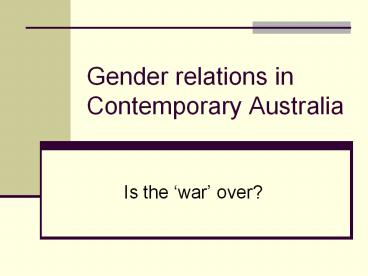Gender relations in Contemporary Australia PowerPoint PPT Presentation
1 / 18
Title: Gender relations in Contemporary Australia
1
Gender relations in Contemporary Australia
- Is the war over?
2
Defining the gender wars
- Is Australia a particularly sexist society?
- How should we characterise the nature of the
relationship between men and women? - Do significant disparities exist along gender
lines? - The crisis for feminism vs the crisis of
masculinity.
3
Defining gender
- Masculinity and femininity refer to the
idealisations of particular qualities,
characteristics, appearances, behaviours that are
attached the male and female sex. - Hegemonic or dominant form of gender identity.
4
Defining gender
- Binary oppositions
- Men as strong, objective, rational, independent,
logical. - Women as weak, subjective, emotional, dependent,
hysterical.
5
Sites of gender socialisation
- The family
- Education
- Work
- Leisure
- Language
- Advertising
6
Advertisements
- Tend to depict women in a limited range of
situations - wife and homemaker
- mother
- sexual object
- Men often depicted as stupid and incompetent
- particularly in the home and afraid of
- commitment.
7
The nation as a gendered entity
- National types constructed around male figures
and a particular kind of masculinity. - Hyper-masculinity
8
A sexist nation?
- Gender imbalance in the 19th century
- The nature of the Australian frontier
- The basic wage
- The role of war in Australian society
9
Gender disparities today?
- Has Australia reached a post-feminist stage of
the debate? Is feminism now redundant? - The end of equality? Issues of gender imbalance
off the national agenda. - The need for a national conversation?
10
Women and politics
- The vote and the right to stand for parliament
both achieved early in Australia. - 1902 Commonwealth Franchise Act
- First woman to gain a seat in parliament in 1943
and then not again until 1966.
11
Women in parliament
- 1994 ALP adopted a policy of affirmative action
to ensure 35 of seats needed to form government
would be filled by women. - The number of women in parliament has climbed in
the 1990s. - One-quarter of Federal parliamentarians are
women. - Women under-represented at the executive level.
12
Women paid work
- Access to paid work a key demand in the struggle
for womens liberation. - 1947 women comprised 22 of the workforce
- 1987 women comprised 37 of the workforce with
the increase of married women from 3 to 22. - 1992 women comprised 42 of the workforce
13
Legislative changes
- 1969 granting of equal pay to women doing work of
the same nature to men. - 1972 equal pay for work of equal value.
- 1975 anti-discrimination legislation
- 1984 Sex Discrimination Act
- 1996 Affirmative Action (Equal Opportunity Act)
14
Women in work in contemporary Australia
- Feminisation of the workforce.
- In August 2002 women comprised 44.5 of the
workforce. - Overall participation of women in the workforce
is 66 - lower than comparable nations like the
US
15
Gender segregation
- Describes the concentration of women and men in
different occupations - Horizontal segregation women and men working in
different occupations - Vertical segregation occupational hierarchies
are also gender hierarchies. - Lower wages for womens work.
- Women continue to earn less than men.
- In 2002 the ratio of the female to the male wage
- was 84.4
16
The national conversation
- Housework
- Childcare
- Maternity leave
17
A crisis for feminism?
- Has feminism achieved its goals? Is it redundant?
- Is feminism relevant for young women?
- Does liberal feminism establish a men as the norm?
18
A masculinity crisis?
- Marginalised and confused by their social roles.
- Linked to changing nature of the workforce and
increased participation of women. - Representations in popular culture of men as
stupid or incompetent

